
Gödöllő is a city in Pest County, Budapest metropolitan area, Hungary, about 30 km (20 mi) northeast from the outskirts of Budapest. Its population is 34,396 according to the 2010 census and is growing rapidly. It can be easily reached from Budapest with the suburban railway (HÉV), and national railway (MÁV-START).

Allerton Castle, also known as Allerton Park, is a Grade I listed nineteenth-century Gothic or Victorian Gothic house at Allerton Mauleverer in North Yorkshire, England. It was rebuilt by architect George Martin, of Baker Street, London in 1843–53.

Lyndhurst, also known as the Jay Gould estate, is a Gothic Revival country house that sits in its own 67-acre (27 ha) park beside the Hudson River in Tarrytown, New York, about a half mile south of the Tappan Zee Bridge on US 9. The house was designated a National Historic Landmark in 1966.
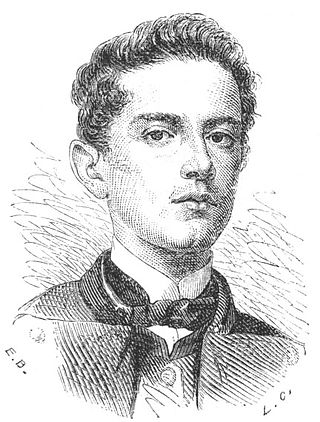
Salvador Agustín Francisco de Paula de Iturbide y Marzán was the grandson of Agustín de Iturbide, the first emperor of independent Mexico, and his wife Empress Ana María. He became the adopted son, along with his cousin Agustín de Iturbide y Green, of Mexico's only other imperial couple—Emperor Maximilian I and Empress Carlota.

María Josepha Sophia de Iturbide was the head of the Imperial House of Mexico from 1925 to 1949. A modest and very religious lady, she played no political role whatsoever. She married twice and had two daughters.
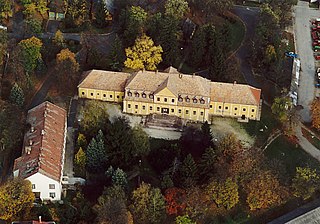
Ádánd is a Hungarian village of 2,416 inhabitants located in Somogy, Hungary, in the south side of lake Balaton.

The Ellwood House was built as a private home by barbed wire entrepreneur Isaac Ellwood in 1879. It is located on First Street in DeKalb, Illinois, United States, in DeKalb County. The Victorian style home, designed by George O. Garnsey, underwent remodeling in 1898-1899 and 1911. The house was originally part of 1,000 acres (4.0 km2) which included a large stable complex known as "Ellwood Green." Isaac Ellwood lived here until 1910 when he passed the estate to his son, Perry Ellwood.

Vaucluse House is a heritage-listed residence, colonial farm and country estate and now tourist attraction, house museum and public park, formerly the home of statesman William Charles Wentworth and his family. It is located at 69a Wentworth Road, Vaucluse in the Municipality of Woollahra local government area of New South Wales, Australia. Completed between 1803 and 1839 in the Gothic Revival style, its design was attributed to W. C. Wentworth and built by Sir Henry Browne Hayes and W. C. Wentworth. The property is owned by the Historic Houses Trust of New South Wales, an agency of the Government of New South Wales. The site was added to the New South Wales State Heritage Register on 2 April 1999.

Kórnik Castle is a castle in the Polish town of Kórnik, which was constructed in the 14th century. The current neogothic design and remodeling was done in 1855 partly on the basis of architect Karl Friedrich Schinkel's plans for Tytus Działyński and the son Jan Kanty Działyński. After last member of Działyński family Jan Kanty Działyński's death, his brother-in-law Count Władysław Zamoyski received the castle in Jan's will. Shortly before his death in 1924, the childless count willed the castle, along with an extensive art collection and the Kórnik Arboretum to the Polish state.

The Hendre, in Rockfield, is the only full-scale Victorian country house in the county of Monmouthshire, Wales. The ancestral estate of the Rolls family, it was the childhood home of Charles Rolls, the motoring and aviation pioneer and the co-founder of Rolls-Royce. Constructed in the Victorian Gothic style, the house was developed by three major architects, George Vaughan Maddox, Thomas Henry Wyatt and Sir Aston Webb. It is located in the civil parish of Llangattock-Vibon-Avel, some 4 miles (6.4 km) north-west of the town of Monmouth. Built in the eighteenth century as a shooting box, it was vastly expanded by the Rolls family in three stages during the nineteenth century. The house is Grade II* listed and is now the clubhouse of the Rolls of Monmouth Golf Club. The gardens and landscape park, mainly laid out by Henry Ernest Milner in the later 19th century, are designated Grade II* on the Cadw/ICOMOS Register of Parks and Gardens of Special Historic Interest in Wales.
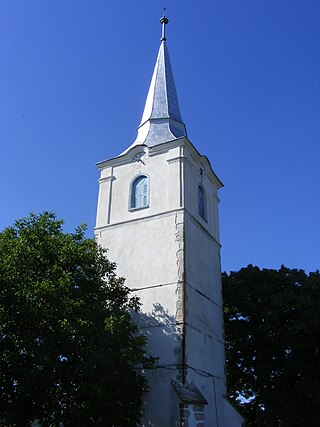
Mărtiniș is a commune in Harghita County, Romania. It is composed of twelve villages: Aldea (Abásfalva), Bădeni (Bágy), Călugăreni (Homoródremete), Chinușu (Kénos), Comănești (Homoródkeményfalva), Ghipeș (Gyepes), Locodeni (Lókod), Mărtiniș, Orășeni (Városfalva), Petreni (Homoródszentpéter), Rareș (Recsenyéd), and Sânpaul (Homoródszentpál).
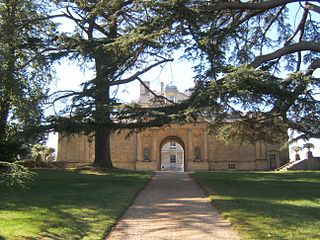
Buscot Park is a country house at Buscot near the town of Faringdon in Oxfordshire within the historic boundaries of Berkshire. It is a Grade II* listed building.

Keele Hall is a 19th-century mansion house at Keele, Staffordshire, England, now standing on the campus of Keele University and serving as the university conference centre. It is a Grade II* listed building.

Hillingdon Court is a Grade II listed mansion in Hillingdon, within the London Borough of Hillingdon. Originally built in 1858 as the family home of the Mills family, the mansion has formed part of the ACS Hillingdon International School since 1978. Much of the remaining grounds came under public ownership in 1928 and have become public parkland and housing.

Ferenc Esterházy de Galántha was a Hungarian noble, who served as Vice-ispán of Pozsony County since 1579. He was the ancestor of the wealthy and prestigious House of Esterházy.
Baron Ádám Viczay de Loós was a Hungarian nobleman, member of the Baron Viczay de Loós family.
Paul from the kindred Szécs, also known as Paul of Komárom, was a Hungarian nobleman and landowner who was lord of Komárom from the 1280s. He came to prominence during the last regnal years of Andrew III of Hungary.

Elvetham Hall is a hotel in Hampshire, England, in the parish of Hartley Wintney about 2 miles (3 km) northwest of Fleet. The building is a High Victorian Gothic Revival English country house and a Grade II* listed building. It stands in a landscaped park that is Grade II listed.
Andrew Kőszegi was a Hungarian lord in the early 14th century, who was a member of the powerful Kőszegi family. His failed rebellion against Charles I of Hungary in 1317 contributed to the gradual collapse of the family's rule in Transdanubia.
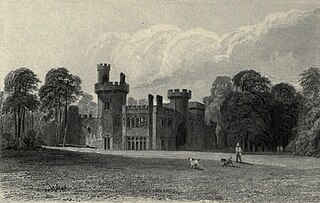
Childwall Hall was a 19th-century English country house located in Childwall, Liverpool, England. Built on the site of a previous mansion of the same name the Gothic Revival building was the seat of parliamentarian Bamber Gascoyne, a noted opponent of the abolition of slavery. The main building was demolished in 1949 and the current site is now occupied by a television production company Lime Pictures. A lodge building and a few ruins of the same style are all that remain of the hall.

















